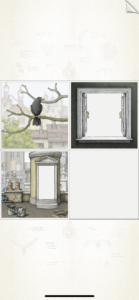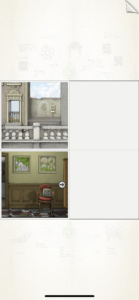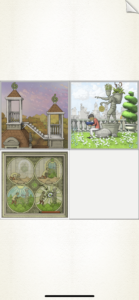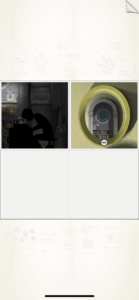For this critical play, I opted to play Gorogoa, which was created by Jason “Jake” Roberts (in his free time as a full-time software engineer!) released by developer Annapurna Interactive for iOS, Google Play, Steam, Switch, and more. I chose to play the game on my iPhone and downloaded it from the App Store.
The App Store page for Gorogoa lists it as appropriate for ages 5+, and I think the only way in which the game would be inaccessible for younger players is the difficulty and complexity of some of its puzzles: many of them require recalling objects in a certain landscape or picture, or timing interactions between elements perfectly to unlock a next stage. As a result, I can imagine the target audience for this game realistically being ages 12 and older.
The three primary mechanics of this game are sliding, zooming into and out of, and panning across tiles containing miniature scenes, and which all lie in a 2 by 2 grid. Below are examples of puzzles being solved:





The game hinges on a (really beautifully illustrated) narrative about a boy finding himself and solving the mystery of a monster ravaging his city. The player ventures inside his thoughts, paintings, drawn doorways, and into space to find five fruits that are connected to the monster, and introduced as an objective at the start of the game. The individual journey to find a fruit constitutes a single chapter, and each chapter is slightly different thematically. For example, the yellow fruit requires toying with sources of light and venturing into an ancient, abandoned kingdom, while the green fruit requires entering a garden with Greek statues.
The simplicity of the game’s mechanics work well with the complexity of the images presented. For example, sometimes you have to slide two squares together to create a new entrance to a different scene, or slide a lantern on top of a start to light it. They cultivate a couple different types of fun: narrative, sensation, fantasy, and discovery. Having the baseline structure of variations on one type of puzzle made it easier to focus and fully enter the game’s “world”.
I thought that the puzzles themselves constituted most of the game (besides cut scenes inserted to advance the narrative). I was surprised by how much I enjoyed the lack of direction in the game; I didn’t miss any clues because the puzzles themselves were intuitive, and there were certain patterns that emerged during gameplay. I also loved the emergent and embedded narratives: the game is so visually beautiful, but none of the visual elements are redundant. This was probably my favorite game I played for a CP so far! My one suggestion for improving the game would be adding minimal dialogue to clarify the narrative, and to possibly introduce other characters to interact with; it sometimes felt a little lonely to only see one character on the screen at all times.



